

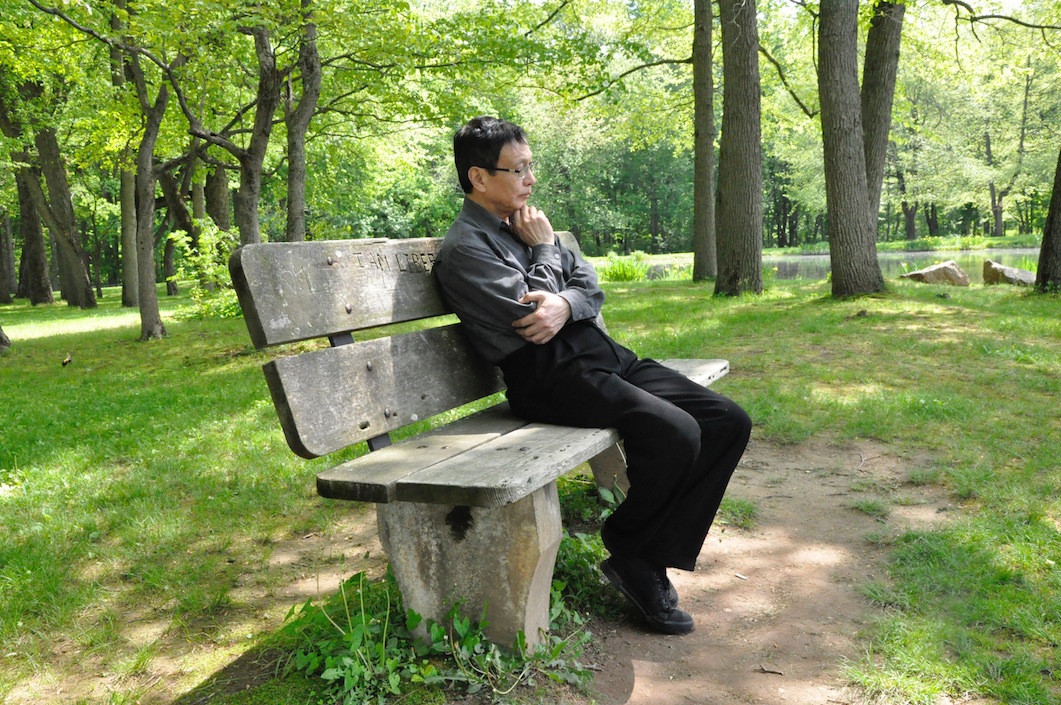
About the Film
 In April 2013, a lecturer at the University of New Hampshire submitted a paper to the Annals of Mathematics. Within weeks word spread: a little-known mathematician, with no permanent job and working in complete isolation, had made an important breakthrough towards solving the Twin Prime Conjecture. Yitang Zhang's techniques for bounding the gaps between primes soon led to rapid incremental progress by the Polymath Group, and then to a further major innovation by James Maynard. The film is a study of Zhang's rise from obscurity and a disadvantaged youth to mathematical celebrity. The story of quiet perseverance amidst adversity, and Zhang's preference for thinking and working in solitude, is interwoven with a history of the Twin Prime Conjecture as told by several mathematicians, many of whom have wrestled with this enormously challenging problem in Number Theory-Daniel Goldston, Kannan Soundararajan, Andrew Granville, Peter Sarnak, Enrico Bombieri, James Maynard, Nicholas Katz, David Eisenbud, Ken Ribet, and Terry Tao.
In April 2013, a lecturer at the University of New Hampshire submitted a paper to the Annals of Mathematics. Within weeks word spread: a little-known mathematician, with no permanent job and working in complete isolation, had made an important breakthrough towards solving the Twin Prime Conjecture. Yitang Zhang's techniques for bounding the gaps between primes soon led to rapid incremental progress by the Polymath Group, and then to a further major innovation by James Maynard. The film is a study of Zhang's rise from obscurity and a disadvantaged youth to mathematical celebrity. The story of quiet perseverance amidst adversity, and Zhang's preference for thinking and working in solitude, is interwoven with a history of the Twin Prime Conjecture as told by several mathematicians, many of whom have wrestled with this enormously challenging problem in Number Theory-Daniel Goldston, Kannan Soundararajan, Andrew Granville, Peter Sarnak, Enrico Bombieri, James Maynard, Nicholas Katz, David Eisenbud, Ken Ribet, and Terry Tao.
Yitang Zhang's breakthrough...
The story of Counting from Infinity: Yitang Zhang and the Twin Prime Conjecture (2015) centers on a very exciting string of mathematical discoveries that occurred during 2013. It started when Yitang Zhang, a virtually unknown mathematician working as adjunct professor at the University of New Hampshire, submitted a paper to the Annals of Mathematics in April 2013. Small Gaps Between Primes was immediately recognized as an important breakthrough, and Yitang, or Tom, became an instant celebrity-a role he was very much unprepared for.
The result has to do with the Twin Prime Conjecture, a very old conjecture in number theory. A prime number is a whole number not divisible by any whole numbers besides itself and 1, such as 3, 5, 7, 11, 13, 17, 19... . Already in ancient times, Euclid proved that there are infinitely many prime numbers. 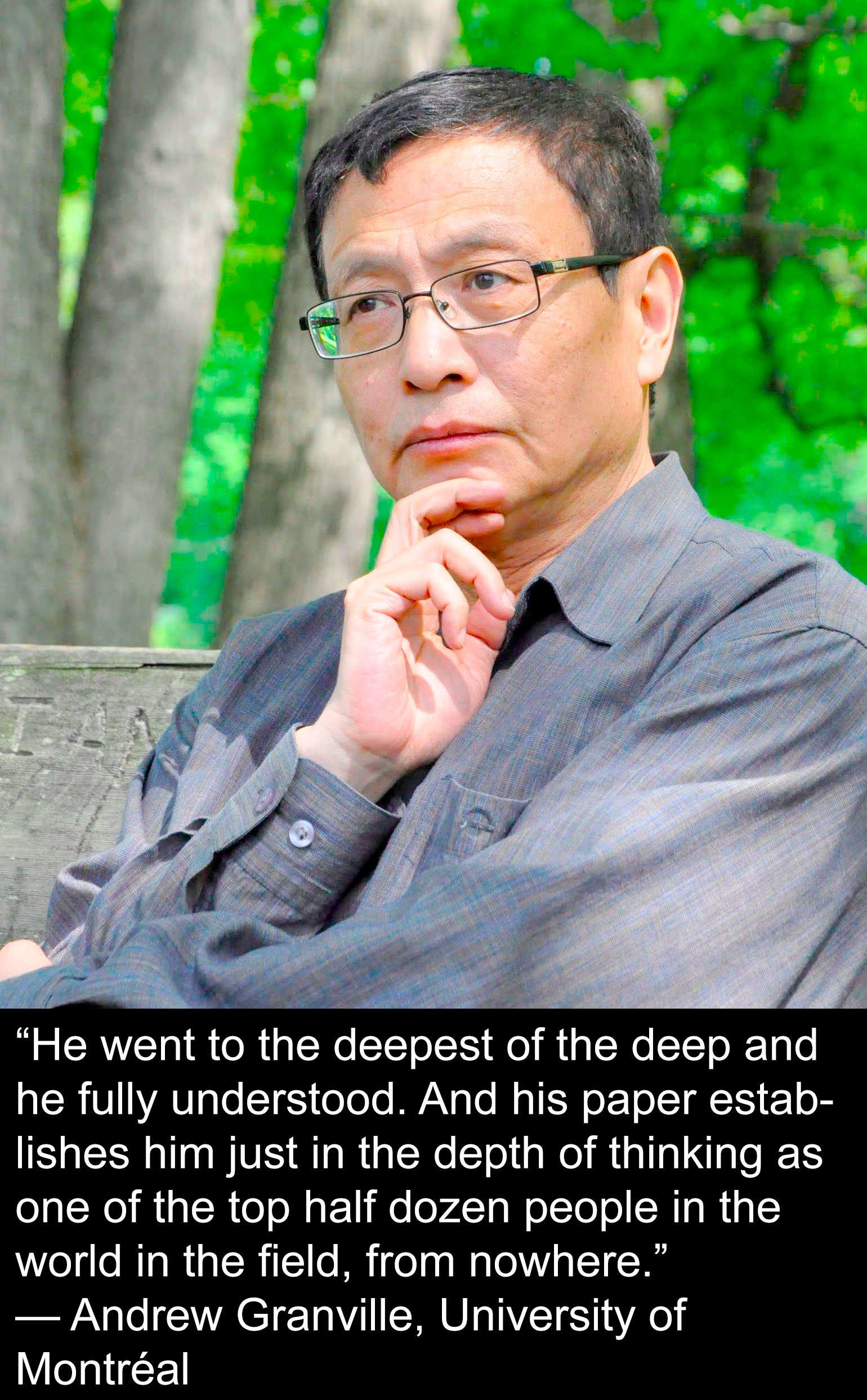 The Twin Prime Conjecture says that there are infinitely many pairs of prime numbers whose difference from one another is just two; for example: The Twin Prime Conjecture says that there are infinitely many pairs of prime numbers whose difference from one another is just two; for example:

7-5 = 2
13-11 = 2
19-17 = 2.
It's known that the average spacing of the primes -- the gaps between them -- get larger and larger as the primes get larger. But there still seem to be some pairs of primes where the gap is quite small, as far out as we can look with computers. The twin prime conjecture would say that though the average gaps keep getting bigger, there are always exceptions where the gap is just 2.
Although mathematicians had tried for centuries to prove this simple statement, before Zhang's work they couldn't even show that there was any number N such that there were always exceptions where the gap is at most N.
 Zhang's breakthrough was to show that there is such a bound N-that you can always find more pairs of primes with a gap at most 70,000,000. Though this number is a lot bigger than 2, it is really small compared to infinity! Zhang's breakthrough was to show that there is such a bound N-that you can always find more pairs of primes with a gap at most 70,000,000. Though this number is a lot bigger than 2, it is really small compared to infinity!
Zhang's work unleashed a flood of new results. A remarkable collaborative effort chipped away at the 70,000,000, making many small breakthroughs. Then James Maynard of Oxford University, using a different approach from Zhang's, brought the number down even further. Today it is under 250. (The goal is still 2; and that still seems far away.) In addition to improving the bound, many other new results have become possible because of Zhang's work.
About the film...
Counting from Infinity was hatched during a brainstorming session between MSRI director David Eisenbud and producer/director George Csicsery in mid-August 2013. Their discussion centered on Zhang's astonishing proof and how little was known about him. While his mathematical achievement was certainly worthy of treatment on film, Yitang Zhang's reputation for being a loner might prove to be an obstacle to telling his story on video.
 Nevertheless, it was decided to go ahead and document Zhang's presentation at the UC Berkeley Math Department's colloquium lecture on September 12, 2013, and to shoot a conversation between him and David at MSRI the next day. A reception at Evans Hall and a dinner in Zhang's honor were also filmed. Fortunately, two important contributors to the story of twin primes were able to join in these events. Kannan Soundararajan from Stanford, and Daniel Goldston from San José State University were also interviewed. The three conversations between Zhang and Eisenbud, Goldston, and Soundararajan were edited into three separate videos, and are available for viewing at MSRI's website.
Nevertheless, it was decided to go ahead and document Zhang's presentation at the UC Berkeley Math Department's colloquium lecture on September 12, 2013, and to shoot a conversation between him and David at MSRI the next day. A reception at Evans Hall and a dinner in Zhang's honor were also filmed. Fortunately, two important contributors to the story of twin primes were able to join in these events. Kannan Soundararajan from Stanford, and Daniel Goldston from San José State University were also interviewed. The three conversations between Zhang and Eisenbud, Goldston, and Soundararajan were edited into three separate videos, and are available for viewing at MSRI's website.

Adding a new dimension to the project was the appearance of Yaling "Helen" Sun, Zhang's wife, at the reception and dinner. Interviewing her provided a different perspective on the reclusive mathematician, and opened a door that later proved invaluable to the portrait of the deeply ethical and compassionate man who emerges in the course of the film.
During the conversation with David Eisenbud, Zhang revealed much about his early life in China. Yitang Zhang was born in 1955, the son of an engineering teacher and a secretary. He spent a part of his childhood living with his grandmother. The persecution of his father during the Cultural Revolution resulted in his exile from Beijing. Living in the countryside with his mother with the barest of necessities and virtually no opportunity for education aside from required propaganda sessions, he taught himself mathematics and developed a lifestyle of austerity. 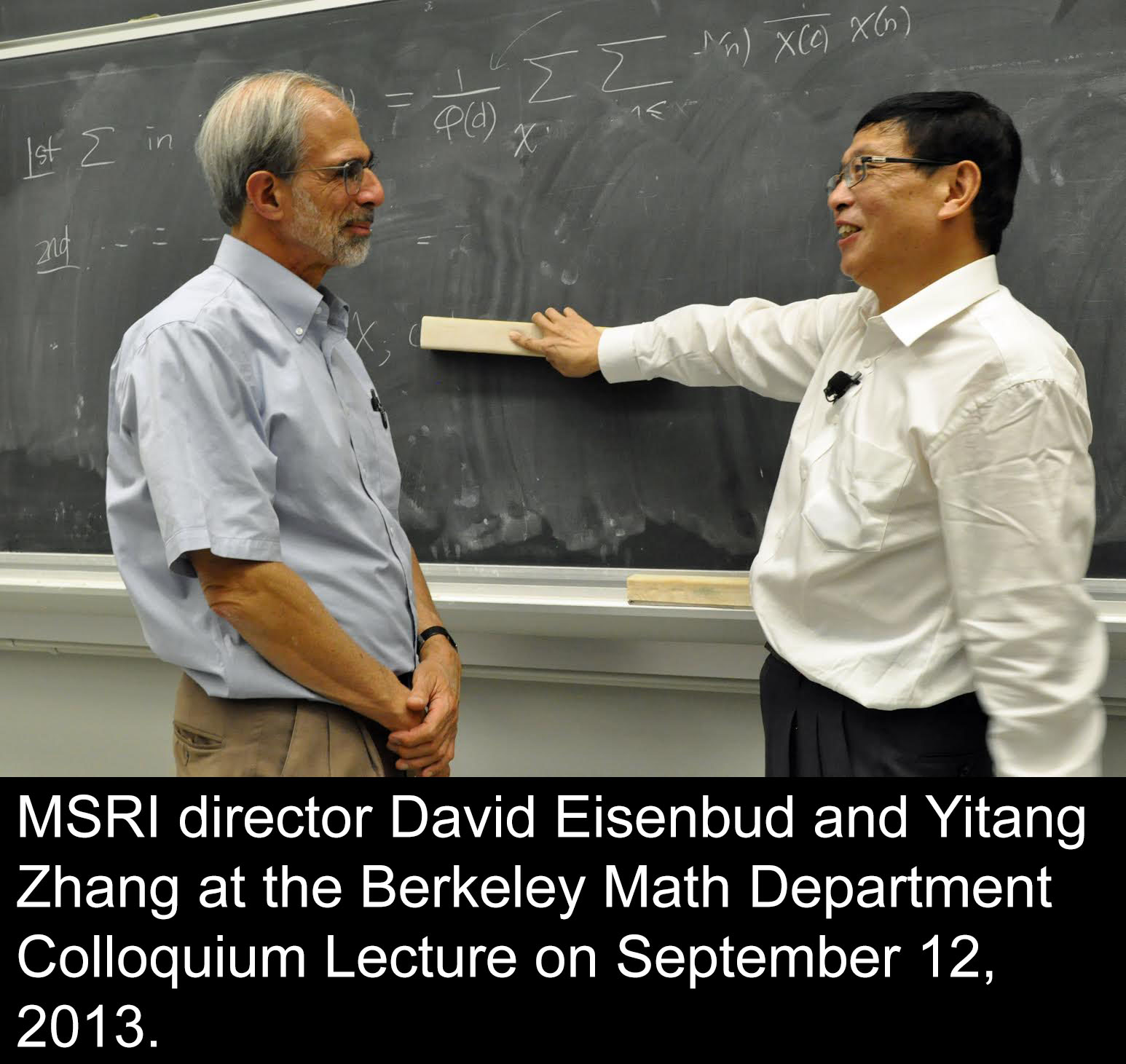 It was during this time of severe deprivation that he learned to cultivate the inner resources that he would later bring to bear on the most challenging of mathematical problems. To this day he cherishes the simple life and eschews the lavish and extravagant. It was during this time of severe deprivation that he learned to cultivate the inner resources that he would later bring to bear on the most challenging of mathematical problems. To this day he cherishes the simple life and eschews the lavish and extravagant.
Zhang got into Beijing University based on examinations. He studied Number Theory, but the trajectory of his work was derailed by a professor who blocked his first opportunity to continue his studies in the United States. After earning his degree, he did get into Purdue University as a graduate student under T. T. Moh. The work he produced under Moh's direction led to further frustration, and he earned his PhD without securing a letter of recommendation from his advisor.
The next shoot with Zhang was in May 2014 at the Institute for Advanced Study in Princeton, where he spent a semester of his sabbatical year doing what he enjoys most: working on problems alone.
 In November 2013, an interview was filmed with Terry Tao, known as one of the greatest mathematicians of our time, who had helped to organize a collaborative Polymath project to reduce the number in Zhang's proof from 70,000,000. In November 2013, an interview was filmed with Terry Tao, known as one of the greatest mathematicians of our time, who had helped to organize a collaborative Polymath project to reduce the number in Zhang's proof from 70,000,000.
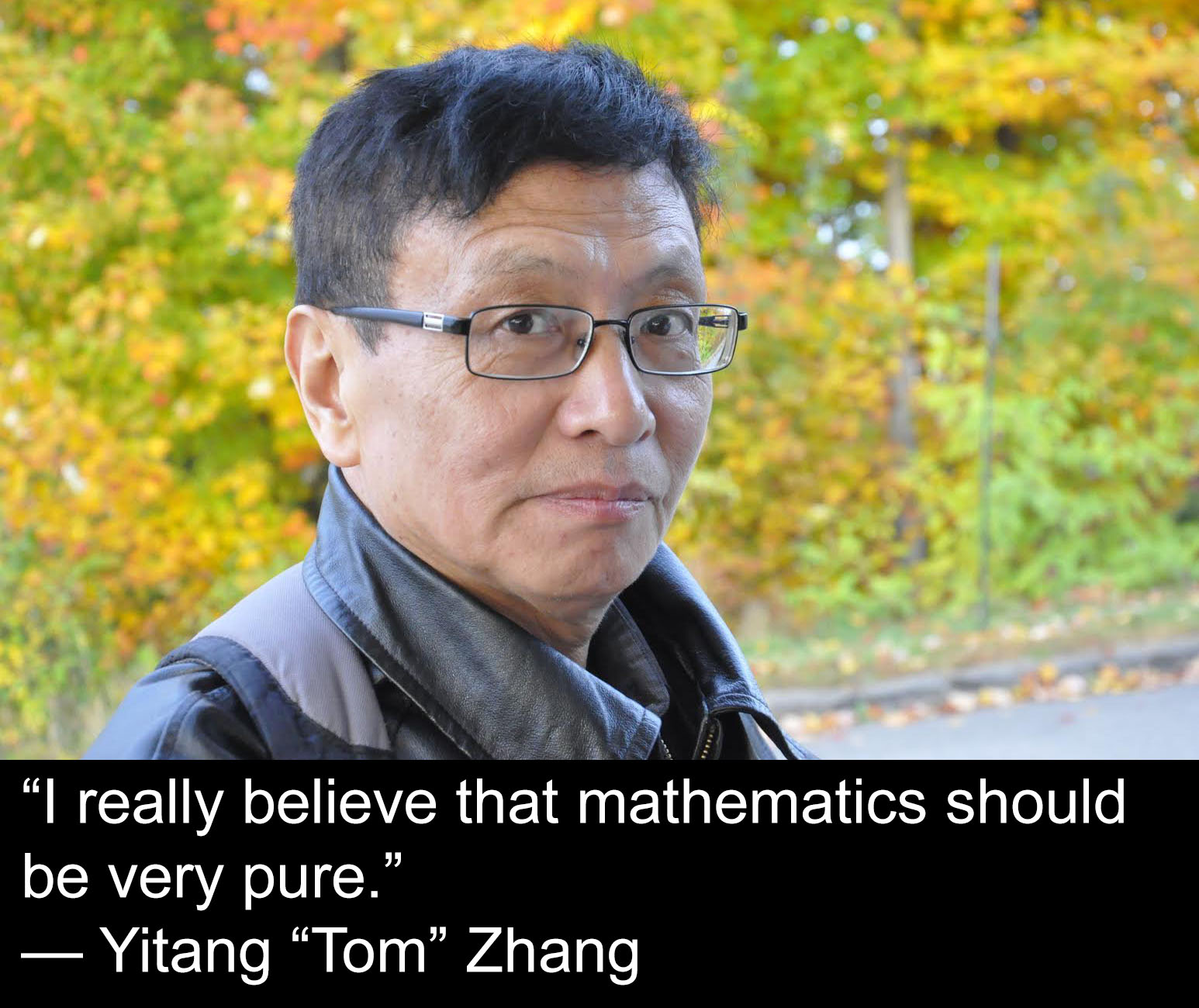 The central challenge of the film was finding a way to depict Yitang Zhang's dedication to working in isolation. The qualities he embraces-solitude, quiet, concentration-are the opposites of those valued in the media. Fortunately, it is a conundrum Csicsery had faced before in other films about mathematicians. He had learned that contrary to the rules, it is okay to shoot long scenes of "the grass growing," or in this case, shots of "a person just sitting with pencil and paper and thinking. The longer the scene, the more you realize that you really can see someone thinking. The human face is very expressive. Give it time and it speaks volumes." The central challenge of the film was finding a way to depict Yitang Zhang's dedication to working in isolation. The qualities he embraces-solitude, quiet, concentration-are the opposites of those valued in the media. Fortunately, it is a conundrum Csicsery had faced before in other films about mathematicians. He had learned that contrary to the rules, it is okay to shoot long scenes of "the grass growing," or in this case, shots of "a person just sitting with pencil and paper and thinking. The longer the scene, the more you realize that you really can see someone thinking. The human face is very expressive. Give it time and it speaks volumes."
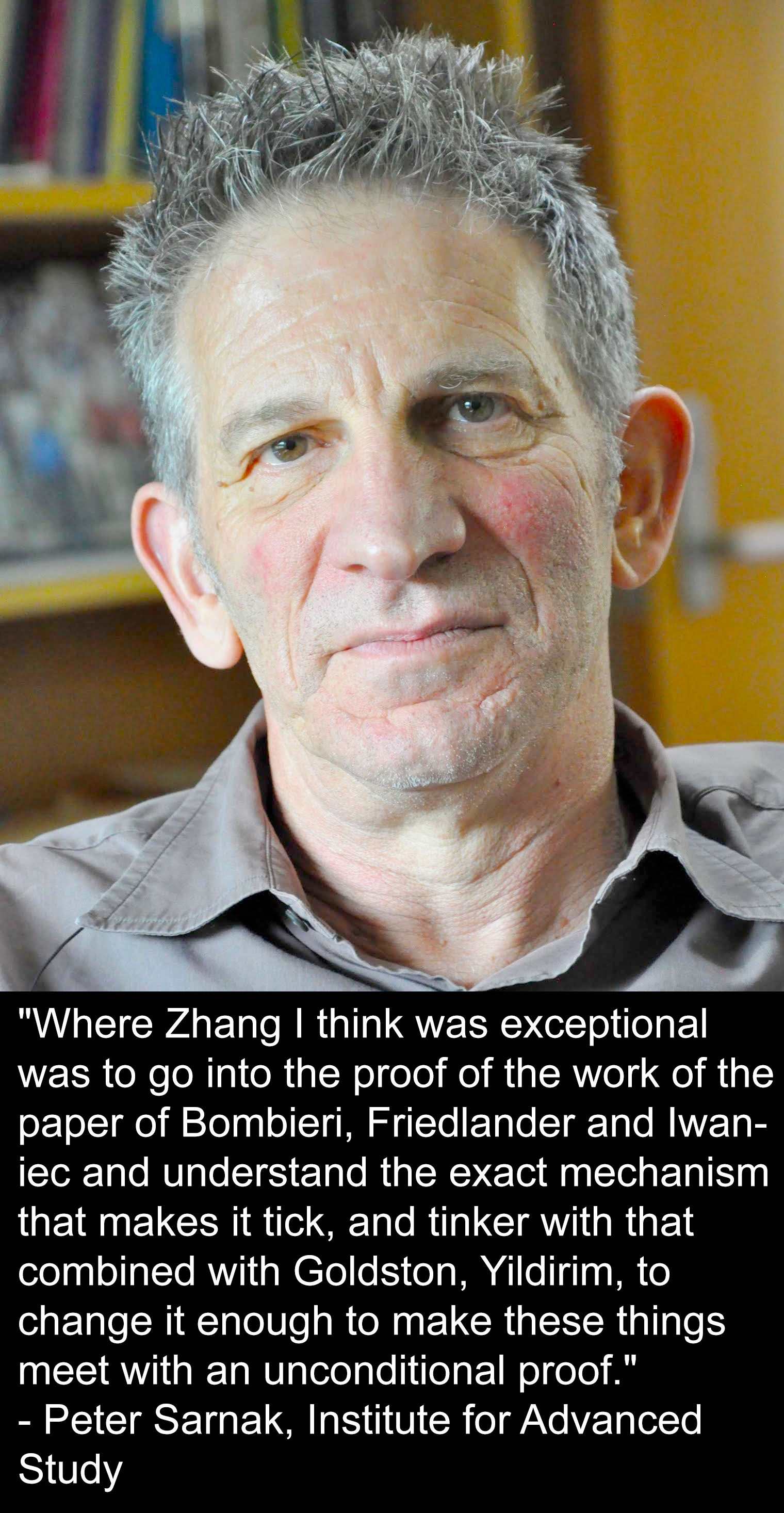 There was a second approach for showing Zhang at work that is a more conventional technique in documentary films. Zhang had revealed to us that he likes to take long walks, and the grounds at the Institute are a beautiful setting. The filmmakers spent an afternoon with him walking around the pond amidst blooming daffodils. They also followed and preceded him home from the institute to the apartment he stayed at. These scenes are invaluable parts of the film. There was a second approach for showing Zhang at work that is a more conventional technique in documentary films. Zhang had revealed to us that he likes to take long walks, and the grounds at the Institute are a beautiful setting. The filmmakers spent an afternoon with him walking around the pond amidst blooming daffodils. They also followed and preceded him home from the institute to the apartment he stayed at. These scenes are invaluable parts of the film.
Being at the Institute provided opportunities to interview three prominent mathematicians to appear in the film.  Nicholas Katz is an editor of the Annals of Mathematics, the journal that published Zhang's proof. He described how the paper went from submission through publication in record time. One of the experts to review Zhang's paper, and a key person in research on the Twin Prime Conjecture and related areas, is Enrico Bombieri. He provided a detailed history of the problem and how truly innovative Zhang's breakthrough really is. Peter Sarnak also gave us perspectives on how Zhang's work, and the more recent results of James Maynard, are changing the mathematical landscape. Nicholas Katz is an editor of the Annals of Mathematics, the journal that published Zhang's proof. He described how the paper went from submission through publication in record time. One of the experts to review Zhang's paper, and a key person in research on the Twin Prime Conjecture and related areas, is Enrico Bombieri. He provided a detailed history of the problem and how truly innovative Zhang's breakthrough really is. Peter Sarnak also gave us perspectives on how Zhang's work, and the more recent results of James Maynard, are changing the mathematical landscape.
 On the last day of filming in Princeton, Yaling arrived, and participated in some additional sequences-walking along the river with Zhang, and a final interview in which they discuss the awards Zhang has earned since his discovery and the lifestyle changes this meant for both of them. On the last day of filming in Princeton, Yaling arrived, and participated in some additional sequences-walking along the river with Zhang, and a final interview in which they discuss the awards Zhang has earned since his discovery and the lifestyle changes this meant for both of them.
At Princeton, Zhang opened his only photo album. The crew photographed and videotaped every picture from his childhood in China, including shots of relatives, his exile on the collective farm in the 1970s, and pictures of his years of education in Beijing and the U.S.
Zhang's work on the twin prime problem spanned several years, but like the other mathematicians who had hit a wall before him, there seemed to be "an insurmountable barrier that needed one more new idea." That new idea arrived, as it often does, when Zhang was taking a break.  He was visiting friends in Pueblo, Colorado, in July 2012, when he went out to their backyard to smoke a cigarette and look for the deer that frequented the yard bordering on a golf course. He explains that suddenly he saw a way around the infamous "square barrier" that had blocked progress on the problem. But he said nothing to his hosts, Jacob Chi and his wife Lin Chang. He was visiting friends in Pueblo, Colorado, in July 2012, when he went out to their backyard to smoke a cigarette and look for the deer that frequented the yard bordering on a golf course. He explains that suddenly he saw a way around the infamous "square barrier" that had blocked progress on the problem. But he said nothing to his hosts, Jacob Chi and his wife Lin Chang.
The first opportunity to visit Jacob Chi and his family came in late July 2014. Interviews with Jacob, Lin and their children Julius and Juliet proved very informative. Jacob had met Yitang Zhang when Zhang was at Purdue and joined an organization of dissident Chinese students advocating democratic reforms and improvements in human rights for China. He became a frequent visitor at Jacob's home, and continued to visit after Jacob became music director of the Pueblo Symphony in Colorado.
 Jacob and Lin spoke of Zhang's deep idealism and his tastes in classical music and literature, as well as his love of wine and cooking. They also described years of hardship after Zhang got his degree. A friend from the Chinese student group they belonged to hired him as an accountant to keep the books for his chain of Subway stores in Lexington, Kentucky. Occasionally, he worked behind the counter. After seven years, another friend helped Zhang land a position as adjunct professor at the University of New Hampshire. He began teaching there in 2000. Jacob and Lin spoke of Zhang's deep idealism and his tastes in classical music and literature, as well as his love of wine and cooking. They also described years of hardship after Zhang got his degree. A friend from the Chinese student group they belonged to hired him as an accountant to keep the books for his chain of Subway stores in Lexington, Kentucky. Occasionally, he worked behind the counter. After seven years, another friend helped Zhang land a position as adjunct professor at the University of New Hampshire. He began teaching there in 2000.
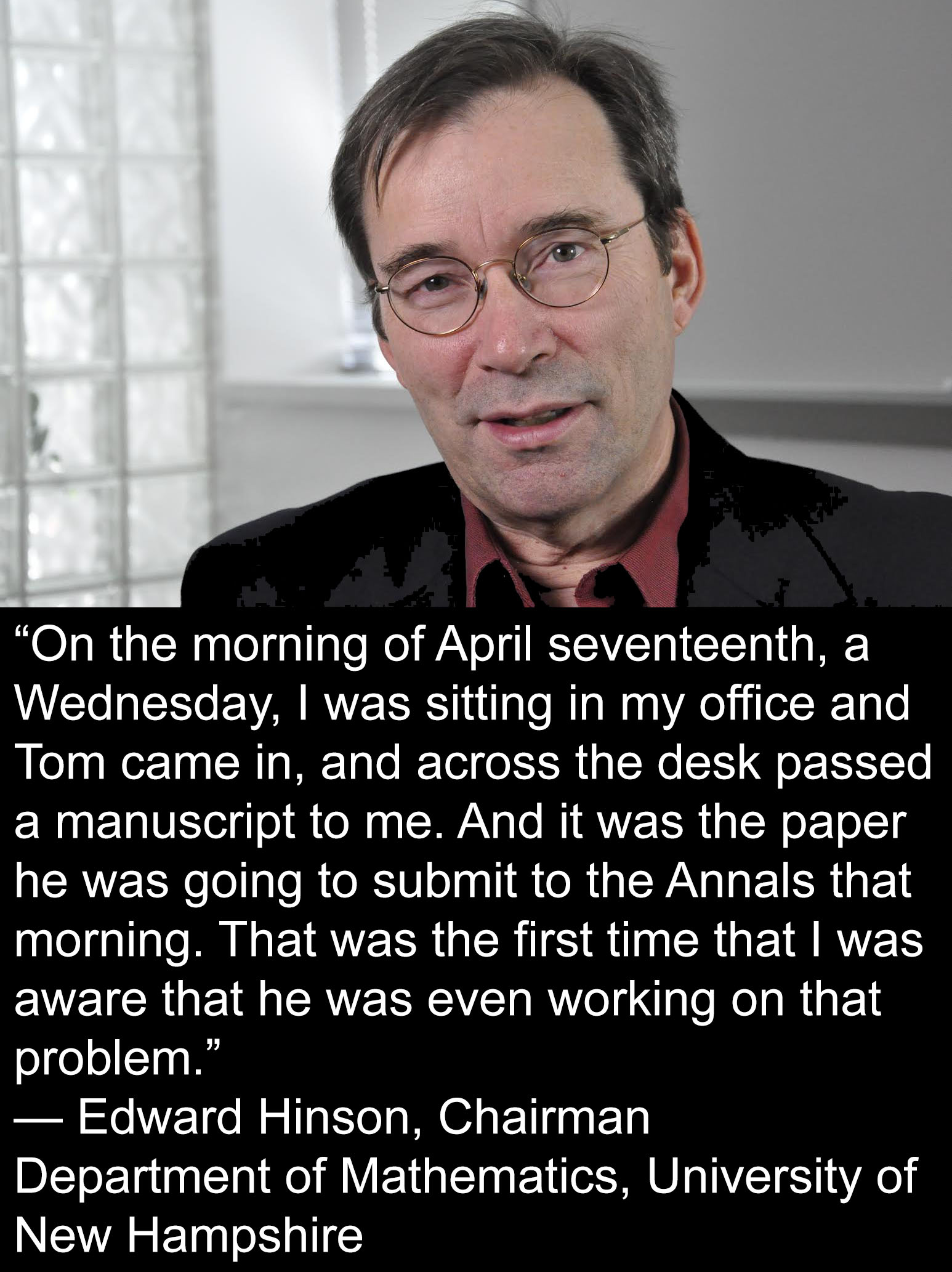 One day of filming in New Hampshire yielded a final interview with Zhang, a chance to watch him teaching a class, and interviews with UNH Chairman of Mathematics Edward Hinson, and three of Zhang's former students. Of course, Hinson and the students were extremely proud of having a celebrity in their midst, especially since in September 2014, Zhang was awarded the prestigious MacArthur Fellowship. This accolade, added to a series of prizes and offers of research positions at the world's top universities, was all the more meaningful to the students and faculty at UNH because Zhang, instead of leaving for more money and a higher status job, had chosen to return to the place where he had taught since 2000. He feels it is somewhere he can "be quiet and do mathematics." One day of filming in New Hampshire yielded a final interview with Zhang, a chance to watch him teaching a class, and interviews with UNH Chairman of Mathematics Edward Hinson, and three of Zhang's former students. Of course, Hinson and the students were extremely proud of having a celebrity in their midst, especially since in September 2014, Zhang was awarded the prestigious MacArthur Fellowship. This accolade, added to a series of prizes and offers of research positions at the world's top universities, was all the more meaningful to the students and faculty at UNH because Zhang, instead of leaving for more money and a higher status job, had chosen to return to the place where he had taught since 2000. He feels it is somewhere he can "be quiet and do mathematics."
The last shoot, at MSRI in Berkeley, centered on an interview with James Maynard, the 27-year-old Oxford mathematician who had reduced the gap between primes through a different approach from Zhang's. His result followed Zhang's by about six months, and was the next major step in the path toward the Twin Prime Conjecture.
 This final shoot took place on November 16, 2014, less than three weeks before the fine cut had to be delivered for color correction and audio mix. This final shoot took place on November 16, 2014, less than three weeks before the fine cut had to be delivered for color correction and audio mix.  By this time, following months of editing, the film's final structure was largely set. Filming concluded with a final interview with David Eisenbud, and bridge narration with mathematician/science writer Erica Klarreich, who had written articles about both Zhang's and Maynard's proofs for Quanta Magazine. By this time, following months of editing, the film's final structure was largely set. Filming concluded with a final interview with David Eisenbud, and bridge narration with mathematician/science writer Erica Klarreich, who had written articles about both Zhang's and Maynard's proofs for Quanta Magazine.
The last weeks of post-production saw the completion and refinement of 28 separate animated sequences created by Andrea Hale. These animations support mathematical explanations in the interviews and the scripted bridge narration written by Erica Klarreich. Original music composed by Richard Chon mixed with subtle sound effects created by E. Larry Oatfield provide an exciting audio bed beneath the narration.
The series of rapid developments around the twin prime problem in 2013, and access to many of the individuals who contributed to the mathematics, allows the film to show how mathematics progresses. In the end, the film contains something for almost everyone: a biographical portrait of a unique individual and the exciting story of his perseverance against adversity, a snapshot of a great moment in mathematical history, and introductions to some compelling personalities in the mathematical community.


Contact:
George Paul Csicsery
Zala Films
PO Box 22833, Oakland, CA 94609 USA
Tel: +1 510 428-9284
Email: geocsi@zalafilms.com
www.zalafilms.com


Copyright © 2015 Zala Films. All rights reserved.
| 



 In April 2013, a lecturer at the University of New Hampshire submitted a paper to the Annals of Mathematics. Within weeks word spread: a little-known mathematician, with no permanent job and working in complete isolation, had made an important breakthrough towards solving the Twin Prime Conjecture. Yitang Zhang's techniques for bounding the gaps between primes soon led to rapid incremental progress by the Polymath Group, and then to a further major innovation by James Maynard. The film is a study of Zhang's rise from obscurity and a disadvantaged youth to mathematical celebrity. The story of quiet perseverance amidst adversity, and Zhang's preference for thinking and working in solitude, is interwoven with a history of the Twin Prime Conjecture as told by several mathematicians, many of whom have wrestled with this enormously challenging problem in Number Theory-Daniel Goldston, Kannan Soundararajan, Andrew Granville, Peter Sarnak, Enrico Bombieri, James Maynard, Nicholas Katz, David Eisenbud, Ken Ribet, and Terry Tao.
In April 2013, a lecturer at the University of New Hampshire submitted a paper to the Annals of Mathematics. Within weeks word spread: a little-known mathematician, with no permanent job and working in complete isolation, had made an important breakthrough towards solving the Twin Prime Conjecture. Yitang Zhang's techniques for bounding the gaps between primes soon led to rapid incremental progress by the Polymath Group, and then to a further major innovation by James Maynard. The film is a study of Zhang's rise from obscurity and a disadvantaged youth to mathematical celebrity. The story of quiet perseverance amidst adversity, and Zhang's preference for thinking and working in solitude, is interwoven with a history of the Twin Prime Conjecture as told by several mathematicians, many of whom have wrestled with this enormously challenging problem in Number Theory-Daniel Goldston, Kannan Soundararajan, Andrew Granville, Peter Sarnak, Enrico Bombieri, James Maynard, Nicholas Katz, David Eisenbud, Ken Ribet, and Terry Tao. The Twin Prime Conjecture says that there are infinitely many pairs of prime numbers whose difference from one another is just two; for example:
The Twin Prime Conjecture says that there are infinitely many pairs of prime numbers whose difference from one another is just two; for example:
 Zhang's breakthrough was to show that there is such a bound N-that you can always find more pairs of primes with a gap at most 70,000,000. Though this number is a lot bigger than 2, it is really small compared to infinity!
Zhang's breakthrough was to show that there is such a bound N-that you can always find more pairs of primes with a gap at most 70,000,000. Though this number is a lot bigger than 2, it is really small compared to infinity! Nevertheless, it was decided to go ahead and document Zhang's presentation at the UC Berkeley Math Department's colloquium lecture on September 12, 2013, and to shoot a conversation between him and David at MSRI the next day. A reception at Evans Hall and a dinner in Zhang's honor were also filmed. Fortunately, two important contributors to the story of twin primes were able to join in these events. Kannan Soundararajan from Stanford, and Daniel Goldston from San José State University were also interviewed. The three conversations between Zhang and Eisenbud, Goldston, and Soundararajan were edited into three separate videos, and are available for viewing at MSRI's website.
Nevertheless, it was decided to go ahead and document Zhang's presentation at the UC Berkeley Math Department's colloquium lecture on September 12, 2013, and to shoot a conversation between him and David at MSRI the next day. A reception at Evans Hall and a dinner in Zhang's honor were also filmed. Fortunately, two important contributors to the story of twin primes were able to join in these events. Kannan Soundararajan from Stanford, and Daniel Goldston from San José State University were also interviewed. The three conversations between Zhang and Eisenbud, Goldston, and Soundararajan were edited into three separate videos, and are available for viewing at MSRI's website. It was during this time of severe deprivation that he learned to cultivate the inner resources that he would later bring to bear on the most challenging of mathematical problems. To this day he cherishes the simple life and eschews the lavish and extravagant.
It was during this time of severe deprivation that he learned to cultivate the inner resources that he would later bring to bear on the most challenging of mathematical problems. To this day he cherishes the simple life and eschews the lavish and extravagant. In November 2013, an interview was filmed with Terry Tao, known as one of the greatest mathematicians of our time, who had helped to organize a collaborative Polymath project to reduce the number in Zhang's proof from 70,000,000.
In November 2013, an interview was filmed with Terry Tao, known as one of the greatest mathematicians of our time, who had helped to organize a collaborative Polymath project to reduce the number in Zhang's proof from 70,000,000.  The central challenge of the film was finding a way to depict Yitang Zhang's dedication to working in isolation. The qualities he embraces-solitude, quiet, concentration-are the opposites of those valued in the media. Fortunately, it is a conundrum Csicsery had faced before in other films about mathematicians. He had learned that contrary to the rules, it is okay to shoot long scenes of "the grass growing," or in this case, shots of "a person just sitting with pencil and paper and thinking. The longer the scene, the more you realize that you really can see someone thinking. The human face is very expressive. Give it time and it speaks volumes."
The central challenge of the film was finding a way to depict Yitang Zhang's dedication to working in isolation. The qualities he embraces-solitude, quiet, concentration-are the opposites of those valued in the media. Fortunately, it is a conundrum Csicsery had faced before in other films about mathematicians. He had learned that contrary to the rules, it is okay to shoot long scenes of "the grass growing," or in this case, shots of "a person just sitting with pencil and paper and thinking. The longer the scene, the more you realize that you really can see someone thinking. The human face is very expressive. Give it time and it speaks volumes." There was a second approach for showing Zhang at work that is a more conventional technique in documentary films. Zhang had revealed to us that he likes to take long walks, and the grounds at the Institute are a beautiful setting. The filmmakers spent an afternoon with him walking around the pond amidst blooming daffodils. They also followed and preceded him home from the institute to the apartment he stayed at. These scenes are invaluable parts of the film.
There was a second approach for showing Zhang at work that is a more conventional technique in documentary films. Zhang had revealed to us that he likes to take long walks, and the grounds at the Institute are a beautiful setting. The filmmakers spent an afternoon with him walking around the pond amidst blooming daffodils. They also followed and preceded him home from the institute to the apartment he stayed at. These scenes are invaluable parts of the film. Nicholas Katz is an editor of the Annals of Mathematics, the journal that published Zhang's proof. He described how the paper went from submission through publication in record time. One of the experts to review Zhang's paper, and a key person in research on the Twin Prime Conjecture and related areas, is Enrico Bombieri. He provided a detailed history of the problem and how truly innovative Zhang's breakthrough really is. Peter Sarnak also gave us perspectives on how Zhang's work, and the more recent results of James Maynard, are changing the mathematical landscape.
Nicholas Katz is an editor of the Annals of Mathematics, the journal that published Zhang's proof. He described how the paper went from submission through publication in record time. One of the experts to review Zhang's paper, and a key person in research on the Twin Prime Conjecture and related areas, is Enrico Bombieri. He provided a detailed history of the problem and how truly innovative Zhang's breakthrough really is. Peter Sarnak also gave us perspectives on how Zhang's work, and the more recent results of James Maynard, are changing the mathematical landscape. On the last day of filming in Princeton, Yaling arrived, and participated in some additional sequences-walking along the river with Zhang, and a final interview in which they discuss the awards Zhang has earned since his discovery and the lifestyle changes this meant for both of them.
On the last day of filming in Princeton, Yaling arrived, and participated in some additional sequences-walking along the river with Zhang, and a final interview in which they discuss the awards Zhang has earned since his discovery and the lifestyle changes this meant for both of them. He was visiting friends in Pueblo, Colorado, in July 2012, when he went out to their backyard to smoke a cigarette and look for the deer that frequented the yard bordering on a golf course. He explains that suddenly he saw a way around the infamous "square barrier" that had blocked progress on the problem. But he said nothing to his hosts, Jacob Chi and his wife Lin Chang.
He was visiting friends in Pueblo, Colorado, in July 2012, when he went out to their backyard to smoke a cigarette and look for the deer that frequented the yard bordering on a golf course. He explains that suddenly he saw a way around the infamous "square barrier" that had blocked progress on the problem. But he said nothing to his hosts, Jacob Chi and his wife Lin Chang. Jacob and Lin spoke of Zhang's deep idealism and his tastes in classical music and literature, as well as his love of wine and cooking. They also described years of hardship after Zhang got his degree. A friend from the Chinese student group they belonged to hired him as an accountant to keep the books for his chain of Subway stores in Lexington, Kentucky. Occasionally, he worked behind the counter. After seven years, another friend helped Zhang land a position as adjunct professor at the University of New Hampshire. He began teaching there in 2000.
Jacob and Lin spoke of Zhang's deep idealism and his tastes in classical music and literature, as well as his love of wine and cooking. They also described years of hardship after Zhang got his degree. A friend from the Chinese student group they belonged to hired him as an accountant to keep the books for his chain of Subway stores in Lexington, Kentucky. Occasionally, he worked behind the counter. After seven years, another friend helped Zhang land a position as adjunct professor at the University of New Hampshire. He began teaching there in 2000. One day of filming in New Hampshire yielded a final interview with Zhang, a chance to watch him teaching a class, and interviews with UNH Chairman of Mathematics Edward Hinson, and three of Zhang's former students. Of course, Hinson and the students were extremely proud of having a celebrity in their midst, especially since in September 2014, Zhang was awarded the prestigious MacArthur Fellowship. This accolade, added to a series of prizes and offers of research positions at the world's top universities, was all the more meaningful to the students and faculty at UNH because Zhang, instead of leaving for more money and a higher status job, had chosen to return to the place where he had taught since 2000. He feels it is somewhere he can "be quiet and do mathematics."
One day of filming in New Hampshire yielded a final interview with Zhang, a chance to watch him teaching a class, and interviews with UNH Chairman of Mathematics Edward Hinson, and three of Zhang's former students. Of course, Hinson and the students were extremely proud of having a celebrity in their midst, especially since in September 2014, Zhang was awarded the prestigious MacArthur Fellowship. This accolade, added to a series of prizes and offers of research positions at the world's top universities, was all the more meaningful to the students and faculty at UNH because Zhang, instead of leaving for more money and a higher status job, had chosen to return to the place where he had taught since 2000. He feels it is somewhere he can "be quiet and do mathematics." This final shoot took place on November 16, 2014, less than three weeks before the fine cut had to be delivered for color correction and audio mix.
This final shoot took place on November 16, 2014, less than three weeks before the fine cut had to be delivered for color correction and audio mix.  By this time, following months of editing, the film's final structure was largely set. Filming concluded with a final interview with David Eisenbud, and bridge narration with mathematician/science writer Erica Klarreich, who had written articles about both Zhang's and Maynard's proofs for Quanta Magazine.
By this time, following months of editing, the film's final structure was largely set. Filming concluded with a final interview with David Eisenbud, and bridge narration with mathematician/science writer Erica Klarreich, who had written articles about both Zhang's and Maynard's proofs for Quanta Magazine. 

